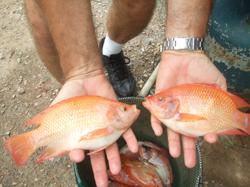Food Security

Food security is a complex sustainable development issue linked to agricultural practices, economic development, environment, and trade. Projects funded by the International Arid Lands Consortium (IALC) have addressed social, economic, and technical drivers threatening food security.
Project Examples
-
Subsurface Drip Irrigation for Vegetables Using Effluent in Arid Lands (2001)
The University of Arizona, Ben-Gurion University of the Negev (Israel), Hebron University (Palestinian Authority) Christopher Y Choi (Principal Investigator)Efficient use of water resources is vital in arid and semiarid regions and can help to ensure a stable food supply. This study was conducted to compare two different irrigation systems, subsurface drip irrigation (SDI) and furrow irrigation (FI), in terms of viral contamination and water use efficiency when tertiary effluent is used for irrigation. The water use efficiency of the SDI system was higher than that of the FI system; since the SDI system supplies water right to the root zone, the crop can use water more efficiently, while furrow-irrigated water has a greater chance of evaporation. Results from this study suggest that deeper installation of drip taps and/or frequent irrigation as alternative practices are appropriate in order to minimize soil surface wetting in SDI plots and reduce potential contamination.
-
Drought-Responsive Genes in Populations From Desert Habitats (1997)
Ben-Gurion University of the Negev (Israel), New Mexico State University
Ariel Novoplansky (Principal Investigator)Sheep and other livestock, and their products, are important sources of both food and economic opportunity in many arid regions and thus the availability of quality forage is critical. The goal of this project was to describe the variability in different populations of desert forage plants, Dactylis glomerata and Trifolium purpureum. Researchers examined whether the genetic complexity for drought response was greater in peripheral or core populations of these plants and found that in both species, the core population variation accounted for most of the variation.
-
Water Conservation Through Drip Irrigated Alfalfa Cropping Systems (1999)
New Mexico State University
Robert Flynn (Principal Investigator)In the irrigated southwestern United States, alfalfa is a major component in the crop rotation schema and uses a large amount of water. The objective of this project was to show the effectiveness of utilizing drip irrigation for alfalfa production, by demonstrating the costs, benefits, and agronomic management practices of subsurface drip irrigation. The researchers demonstrated that alfalfa yields can be maintained while reducing water application by at least 40% using drip irrigation versus sprinkler irrigation. The use of drought tolerant crop varieties to further improve water savings was also demonstrated.

